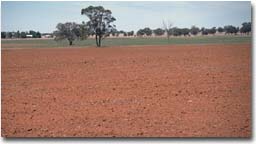Soils of the North Central Region
The North Central Region has the following Soil Orders that you can link to. These Soil Orders have been classified using the Australian Soil Classification.
Calcarosols | Vertosols | Sodosols | Chromosols | Dermosols | Tenosols | Ferrosols
Broadscale overview soil maps are presented for each soil order and should only be used as a general indication of their distribution. There are four main Soil Categories in the North Central Region and these are listed below. Each of these Soil Categories contain one or more Soil Orders. |  A cropping soil near Bridgewater |
| |
Texture Contrast Soils
Texture contrast soils are those that display strong texture contrast between the surface (A horizons) and the subsoil (B horizons) e.g. sand or loam over clay.
In the North Central Region, there is a range of soils with strong texture contrast, previously referred to as Duplex soils using the Northcote Factual Key.
Using the Australian Soil Classification there are three Soil Orders represented, based on subsoil chemistry (specifically pH):
- Chromosols
- Sodosols
Sodosols have subsoils which are not strongly acid (i.e. pH >5.5 in water) but are sodic. Their surface texture ranges from sandy loam to clay loam over medium to heavy clay. Sodosols are widespread throughout and frequently occur on the older alluvial plains in the north and on sedimentary hills and rises.
Soils Lacking Strong Texture Contrast
There are a number of soils in the North Central Region which lack strong texture contrast between the surface and subsoil horizons. These soils have previously been referred to as Gradational soils using the Northcote Factual Key. Using the Australian Soil Classification they are classified as:
- Dermosols
- Ferrosols
- Calcarosols
Ferrosols are deep, well-structured and friable soils that have formed on basalt. They are high in free iron oxide and clay, and are generally strongly acid. These also occur in the south-east of the region.
Calcarosols are calcareous throughout and often contain calcium carbonate as soft or hard fragments. They are most common in the north-west of the region where rainfall is lower.
Cracking Clay Soils
These soils are referred to as Vertosols. These are clay soils that shrink and swell, and crack as the soil dries. They are most common in the northern plains area in the north of the region. These are common on large flodplains beside the Murray, Loddon and Wimmera rivers.
Shallow Soils
Tenosols are shallow, weakly developed soils that show more profile development than Rudosols. They generally have low water holding capacity and fertility. In the North Central region they are most commonly associated with steep hills on sedimentary rock.


